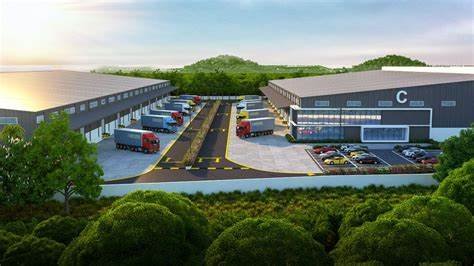The project mainly consists of several PEBs, with a cumulative area of more than a million square feet, to be constructed in phases. This warehouse park is situated near Hyderabad (T.S.), India. The PEB designed in the first phase is a warehouse with an area of 1,90,000 sq. ft.
Structural Details
The warehouse is modeled as a space frame, with 23 single-gable multi-span frames at 8m spacing. For alternate main frames, there are three intermediate columns, in addition to the end columns, thus making the transverse column-to-column spacing as 25m. Remaining frames rest on jack beams that run along three intermediate rows for the entire length of the PEB.
The 16m long jack beams serve as intermediate supports for alternate frames. There is a 5m wide cantilever canopy on one side that runs along the full building length. It is in reverse slope with 5m clearance above the warehouse floor.
The choice of space frame, instead of a plane frame, was based on below criteria:
- To depict correct structure sway and deflections in the longitudinal direction.
- To enable the design of longitudinal braces, for both columns and rafters.
- To design wind columns at gable ends.
- To allow the consultant, the flexibility to change the intermediate columns to ‘trestles’, if a need be.
- To account for torsional forces induced, as a result of eccentricity between center of mass and center of resultant force, for the various load cases.
Consultant started the structure analysis & design with ‘pinned’ support approach. But, after completion of the geotechnical investigation, the existence of shallow hard rock strata, with an SBC of 2,000 kN/sq.m was ascertained. It was then that the support type was changed suitably to transfer most of the lateral forces, i.e. shears and moments, onto the sub-soil. As a result, member deflections, structure drifts and lateral sways could be kept within permissible limits, with relatively lighter column and beam elements. Though this resulted in 60 per cent more foundation cost, the overall project cost came down by approximately 16 per cent i.e. by around INR 15 Million.
Sayed Hyder Hussaini
Managing Director, Epicenter Consulting Engineers Pvt Ltd
Challenges
The 5m cantilever canopy, on one side of the building, posed some difficulty initially. With ‘pinned’ column support, the cantilever deflection was beyond acceptable limits. In view of this, and the presence of hard rock at founding depth, the support was changed to ‘fixed’ type. Isolated footings had been designed several times for various support options, to reduce structure cost.
The consultant used a customized footing design software, requiring less than a minute per footing design, which helped them design the foundation system in the most economical way. And, with their customized wind load calculator, they were able to absorb client’s changing requirements with extreme ease.

Salient Features
Structural design was done as per AISC–ASD, while serviceability criteria were based on MBMA-2006 and the structure was located in seismic zone-2. Wind loads were calculated as per IS 875 (Part 3): 2015 with below wind parameters:
- Basic wind speed = 44 m/s.
- Design life (for k1): 50 Years.
- Structure class (for k1): General building.
- Terrain (for k2): Category 2.
- Topography factor (k3): 1.00 (Upwind slope < 3⁰).
- Importance factor (k4): 1.00 (Other structures).
- Wind directionality factor (Kd): 0.9
- Area averaging factor (Ka): Depending on tributary area.
- Combination factor (Kc): 0.9
The warehouse had sprinklers and solar panels as roof loads, in addition to the usual live loads. The ‘ka’ factor was calculated separately for columns and rafters to get accurate loads on the various elements. This may have contributed to an extent, to overall structure economy, as it were the wind load combinations that governed the structural design for most members. The effect of canopy and roof monitor, on design wind pressures for members adjacent to those, was carefully considered while applying wind loads on the columns and rafters. Roof monitor was modeled, primarily, to enable application of correct wind pressures on windward and leeward rafters, and on the monitor itself. The presence of the roof monitor induced appreciable amount of additional shear in the extreme columns.
A customized automated template was especially prepared to obtain the design wind pressures for the various structural elements of the warehouse. As a result, consultant could try several design options, with different structural configurations, to arrive at the one with the perfect balance between strength, serviceability and structure optimization criteria. Wind was considered from each of 4 horizontal directions, considering both pressure and suction inside, thus, making it a total of 8 load cases for wind alone.
While a single-gable frame, for a width as large as 100m, is uncommon for warehouses, the primary challenge was to keep the overall height to within 18.5m above the road level. The 5m long cantilevers, over the entire warehouse length, were unique to this warehouse. The other unique feature was the exceptionally high soil SBC that enabled the consultant to reduce the super-structure cost by tactical support selection, and with heavier foundation design.





